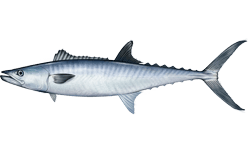King mackerel facts for kids
Quick facts for kids King mackerel |
|
|---|---|
 |
|
| Conservation status | |
| Scientific classification | |
| Synonyms | |
|
The king mackerel (Scomberomorus cavalla), also called surmayi or kingfish, is a type of mackerel that travels a lot. It lives in the western Atlantic Ocean and the Gulf of Mexico. This fish is very important for both commercial fishing (catching fish to sell) and recreational fishing (catching fish for fun).
Contents
About King Mackerel
King mackerel are medium-sized fish. They usually weigh from 5 to 14 kilograms (about 11 to 31 pounds). Some can even weigh over 40 kilograms (about 88 pounds)! Their bodies are covered with tiny scales that are hard to see and are not tightly attached.
The first fin on their back, called the dorsal fin, has spines and is usually folded back into a groove on their body. Their side fins, called pelvic fins, also fold back. A line along their side, called the lateral line, starts high on the shoulder. It then dips down in the middle of the body and continues as a wavy line to the tail.
King mackerel are olive green on their back. Their sides are silvery with a pinkish shine, and their belly is white. Younger fish, weighing less than 5 kilograms (about 11 pounds), have yellowish-brown spots on their sides. These spots are smaller than those on the Atlantic Spanish mackerel. King mackerel have large, sharp teeth that are flat and close together. These teeth look a lot like those of the bluefish.
Where They Live
King mackerel are found in warm waters along the Atlantic Coast of the Americas. They are common from North Carolina all the way down to Brazil. You can find them as far south as Rio de Janeiro and sometimes as far north as the Gulf of Maine. They are also found on the western coast of India in the Arabian Sea and on the eastern coast in the Bay of Bengal in the Indian Ocean.
These fish prefer water temperatures between 20 and 29 degrees Celsius (68 to 84 degrees Fahrenheit). They usually live in waters that are 12 to 45 meters (about 40 to 150 feet) deep. Larger king mackerel, weighing more than 9 kilograms (about 20 pounds), often live closer to shore. They can be found near the mouths of inlets and harbors. Sometimes, they even go into deeper waters, up to 180 meters (about 590 feet) deep, at the edge of the Gulf Stream.
How They Travel
King mackerel travel a lot! They move based on changes in water temperature and how much food is available. They swim in large groups, called schools. In the summer, they travel to the northern parts of their range. In the winter, they move south.
Both the king mackerel from the South Atlantic and the Gulf of Mexico meet up in a special winter area. This area is in Monroe County, Florida, south of the Florida Keys. They gather there between November and March.
King Mackerel Life Cycle
A female king mackerel can lay a lot of eggs, from 50,000 to several million, during the spawning season. The eggs hatch in about 24 hours. When they first hatch, the baby fish, called larvae, are very tiny, only about 2.5 millimeters (0.1 inches) long. They have a large yolk sac for food.
Scientists don't know much about king mackerel during their first year of life. By the time they are one year old, they usually weigh about 1.4 to 1.8 kilograms (about 3 to 4 pounds). They are about 60 centimeters (24 inches) long from their nose to the fork in their tail.
When they are seven years old, female king mackerel average about 10 kilograms (22 pounds). Males average about 5 kilograms (11 pounds). While king mackerel can grow to 40 kilograms (88 pounds), any fish over 7 kilograms (15 pounds) is almost always a female.
What They Eat
King mackerel are very hungry fish that eat many different things. What they eat depends on their size. Depending on where they are and the time of year, they like to eat:
- Squid
- Small, sardine-like fish such as menhaden
- Jacks
- Cutlassfish
- Weakfish
- Grunts
- Striped anchovies
- Cigar minnows
- Threadfin
- Northern mackerel
- Blue runners
Fishing for King Mackerel
King mackerel are some of the most popular fish for sport fishing. People love to catch them from North Carolina to Texas. They are known for being very fast swimmers.
Fishermen mostly catch them by trolling. This means dragging fishing lines with bait or lures behind a moving boat. They use different kinds of live and dead baitfish, as well as artificial lures like spoons and jigs.
For commercial fishing, large nets called gill nets are used. Commercial fishermen also troll with heavy fishing gear and lures similar to those used by sport fishermen. When using live bait, two hooks are often tied to a strong metal leader. One hook goes through the bait fish's nose or mouth. The second hook is placed through the back or left to swing freely. This is because king mackerel often bite the tail of a bait fish. When trolling with live bait, it's important to make sure the bait fish swims correctly.
Typical fishing gear includes a reel that can hold about 340 meters (370 yards) of 13-kilogram (30-pound) test fishing line. The rod is usually about 2 meters (6.5 feet) long and designed for 13-kilogram (30-pound) class fish.
King Mackerel as Food
King mackerel are mostly sold fresh. You can buy them as fillets (boneless pieces), steaks, or whole fish. Their raw meat looks grayish because it has a lot of fat. They taste best when grilled, fried, baked, or smoked. Smoking is especially good for large king mackerel.

Important Nutrition Information
The United States Food and Drug Administration (FDA) says that king mackerel is one of four types of fish that children and pregnant women should avoid. The other fish are swordfish, shark, and tilefish. This is because these fish can have high levels of methylmercury. Eating too much fish with high mercury can be harmful. It's always a good idea to check seafood advisories, especially for kids and pregnant women.
Fish That Look Similar
Small king mackerel look a lot like Atlantic Spanish mackerel (Scomberomorus maculatus) and cero mackerel (Scomberomorus regalis). All three fish have similar shapes and colors. Here's how you can tell them apart:
- The lateral line (the line along the side of the fish) on Atlantic Spanish mackerel and cero mackerel slopes gently from the top of the gill to the tail. But on the king mackerel, this line drops sharply in the middle of its body.
- The first spiny dorsal fin on Atlantic Spanish mackerel and cero mackerel has a clear black patch. The king mackerel does not have this black patch. Since all three fish usually keep this fin folded back, you might not see this difference right away.
- Atlantic Spanish mackerel have clear yellow spots on their sides at all sizes. Cero mackerel have yellow spots and one or more yellow stripes along their middle. Young king mackerel have similar, but slightly smaller, spots. These spots fade away on fish weighing over 5 kilograms (11 pounds). However, you might still see them as slightly darker green spots from certain angles.
Around the world, many fish from these three species look quite similar to each other. For example, off the coast of Mexico, Atlantic Spanish mackerel can be confused with Serra Spanish mackerel (Scomberomorus brasiliensis).
See also
- Mackerel as food




